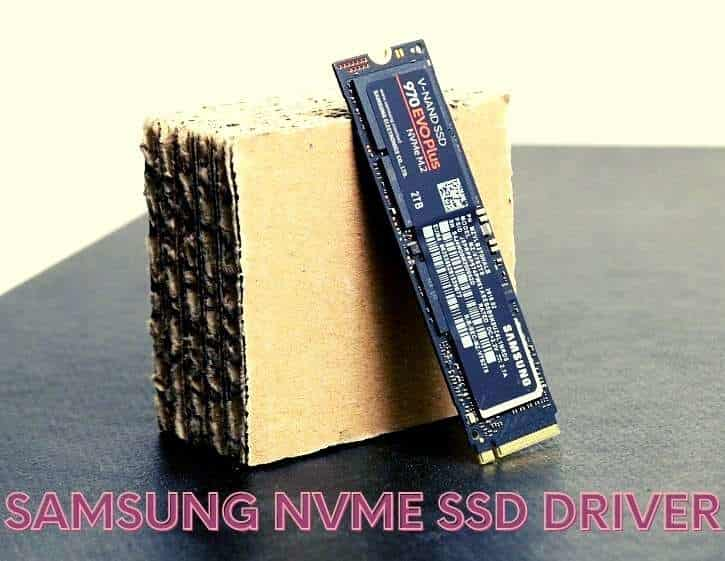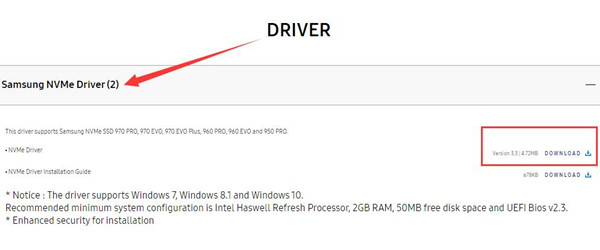

- #Samsung nvme driver extracted install
- #Samsung nvme driver extracted 64 Bit
- #Samsung nvme driver extracted zip file
- #Samsung nvme driver extracted drivers
- #Samsung nvme driver extracted update
#Samsung nvme driver extracted install
Then during Windows Setup, when you get to the point where you choose where you want to install Windows, you'll see a Load Driver option.
#Samsung nvme driver extracted zip file
The way it's supposed to work is that if you want to use RAID mode, you need to download the "F6 floppy" version of the Rapid Storage driver here, then extract the zip file onto something like a flash drive. I'm not sure how you tried to install the Rapid Storage driver in some other situation.
#Samsung nvme driver extracted drivers
Did you perform a clean install using Windows 10 media downloaded directly from Microsoft rather than Dell, just to get as clean a setup as possible? If so, then if you've already installed and updated all necessary drivers in Windows, unfortunately I don't have any further suggestions at this point, but I'll reply back if any come to If you want to use RAID mode, you need to set that before you install Windows and then provide the Intel RST driver during Windows installation. I have an with the same SSD running Windows 10 and I get speeds similar to what you're seeing in Linux. You definitely don't need special drivers to get performance faster than that. However, if you're trying to run Linux, to my knowledge you have to use AHCI mode because I don't think Linux has a suitable driver for the Intel RST controller that gets enabled when you select RAID mode.Īll that said, that doesn't explain why your SSD is so slow in Windows. AHCI choice is made in the BIOS, specifically the setting called "SATA Operation", which despite the name affects NVMe devices as well. If it's in AHCI mode, then the Microsoft NVMe driver built into Windows is used. If your system is in RAID mode, then the Intel Rapid Storage driver is used. It's true that Samsung's NVMe drivers don't work on OEM units, but Dell doesn't provide drivers either.

If you're in RAID mode, then you can only use the Intel RST driver regardless of SSD type. If you want to use the Samsung drivers instead, your system has to be in AHCI mode AND you have to be using a Samsung retail SSD, not an OEM versions like the PM951. RAID drivers, when your system is in AHCI mode, you can always use the Microsoft NVMe driver built into Windows if you want.

The RAID mode speed won't be significantly different if you perform multiple benchmarks in both AHCI and RAID mode and average out the results.Īs for AHCI vs.
#Samsung nvme driver extracted update
(Note: If you already see your SSD before loading the driver, you can skip this, because it means Windows has a new enough RST driver built in, so you can wait to update it until Windows is installed.) Click that and point to the INF file in the driver you downloaded. The link to the NVMe driver you can load during the Windows 7 installation is in the guide:Ī direct link to a Samsung NVMe driver you can use with a Windows 7 installation can be found on the page below.If you want to use RAID mode, you need to set that before you install Windows and then provide the Intel RST driver during Windows installation. If you need to use this guide, you must be careful to do every step perfectly. Windows 8.1 and 10 do not have these problems.įirst there is the problem with no USB 3.0 driver, and second no NVMe driver.īelow is a link to a guide for installing Windows 7 on an Intel 100 series chipset board (like you have), using an NVMe SSD as the Windows drive. You are trying to do two difficult things at the same time, difficult because you are using Windows 7. There is a link to a website where you can download that driver at the end of this post. The NVMe driver files have been extracted from the Samsung NVMe driver installation program, which normally can only be used once Windows is installed. But it is not in the correct format for use with a Windows installation. Samsung provides an NVMe driver on the information page of the 960 EVO. Windows 7 does not have a built in NMVe driver in its installation program, which is why the 960 EVO is not found. The 960 EVO is an NVMe SSD, a new and different storage protocol than SATA. What need to do in order to fix it ? Need to install a driver ? I see the disk on bios but in the step that need to choose the disk in order to install windows i can't find it.

#Samsung nvme driver extracted 64 Bit
I try to install windows 7 64 bit but i can't make it. Hi, i have a H170 perfomance motherboard and a m2 ssd 960 evo samsung.


 0 kommentar(er)
0 kommentar(er)
